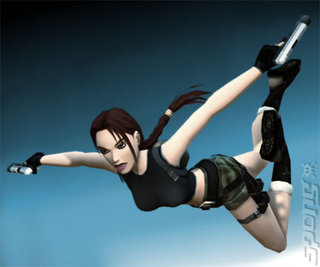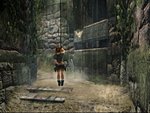Companies:
Crystal Dynamics Eidos SCi
People: Eric Lindstrom
Games: Tomb Raider: Underworld Tomb Raider: Anniversary Lara Croft Tomb Raider: Legend
People: Eric Lindstrom
Games: Tomb Raider: Underworld Tomb Raider: Anniversary Lara Croft Tomb Raider: Legend
Now I’ve heard of role-play, but this is ridiculous. To help promote the up and coming Tomb Raider Underworld, Eidos transformed the luxurious Luton Hoo mansion into ‘Croft Manor’, complete with the lovely new Lara model, Alison Carroll, greeting us at the door. Luckily the coach ride there from London wasn’t too squeamish; else I’d have probably dirtied her red carpet. Coaches aren’t my forte.
After being led through several large and extravagant rooms, each more magnificent than the last, I was treated to some good old-fashioned tea and biscuits while the press waited for the morning’s press conference to begin. Eric Lindstrom, Crystal Dynamic’s Creative Director of Tomb Raider Underworld, took to the stage and battled his wounds (well, a sore throat) to detail the first few levels of Lara’s new adventure.
The audience was treated to a demonstration of the new training level – set in a burning Croft Manor, with the player having to escape Lara’s home whilst being treated to a tutorial of the game’s controls. There were also showcases of the first stage, set in an ocean that really proved the advances made in the graphical department, and the Thailand setting, which SPOnG demoed a few weeks ago.
I managed to sit down with Eric for a few moments to talk more about Crystal Dynamic’s status as ‘the Tomb Raider studio’ and the new features in Underworld.
SPOnG: Thanks very much for joining me Eric, could you just give me a brief history of your career in games development, and where you started in gaming?
Eric Lindstrom: My gosh, that’s going back a long time ago. Well, I started my career as a tester for Epyx back in 1988 for about a year and then went onto Electronic Arts. I was at EA for about four or five years as a writer, doing manual writing and stuff like that. I got into game design shortly after – the story work for Hardnova on PC, and the writing for The Lost Files of Sherlock Holmes.
Round about then I was doing game design work most of the time, but there was no such thing as a ‘game design’ function in Electronic Arts, so to speak. I kinda suggested, 'Maybe it’s time we made one' and the company wasn’t really ready to make that jump yet, so I moved over to Crystal Dynamics to become a full-time game designer in the early 1990s.
Then I did Solar Eclipse for the Saturn and a few projects were kick-started that I didn’t really see to completion, but those games would become Akuji the Heartless and Whiplash. Then I did a lot of research and development for Electronic Arts and later came back to Crystal just after the core team of Tomb Raider Legend was formed. I became the story, scenario, construction designer and for that and then started Tomb Raider Underworld pretty much as we were waiting for Legend to clear submission.
SPOnG: Crystal Dynamics have been involved with Tomb Raider since Legend and Anniversary. What was it about the franchise that you learned from working on those two games that inspired you to improve upon that for Underworld?
Eric Lindstrom: What we did with Legend was analyse what was really special and unique about TR and Lara Croft. What made her so successful? I mean, people were hungry for good Tomb Raider games, and we wanted to know why, because that’s where her success would lie. We found out that people really were connecting to the emotional adventure of it, the discovery of new forgotten places and the exploration of those places.
It has its own unique feel to it that’s not about violence, and it’s not about… it’s hard to describe. I mean we have pages of information that help us understand what this (franchise) is. And we’re very happy with what we did on Legend but at the same time we were trying to do a lot of things. Building a new engine, doing this type of game-play and so on – so that at the end there were so many lessons we learned that we wanted to move on and implement them in Underworld.
Basically, we wanted to do everything we did right and then do all these other things that we learned along the way to make that kind of adventure. The biggest lesson we learned was that details really matter, but at the same time what people love about Tomb Raider isn’t in a particular set of details.
If you talk about the details of Tomb Raider 1, it was tractor controls, jumping to your death… all kinds of things that people remember because there’s that something that they love about the nature of TR.
After being led through several large and extravagant rooms, each more magnificent than the last, I was treated to some good old-fashioned tea and biscuits while the press waited for the morning’s press conference to begin. Eric Lindstrom, Crystal Dynamic’s Creative Director of Tomb Raider Underworld, took to the stage and battled his wounds (well, a sore throat) to detail the first few levels of Lara’s new adventure.
The audience was treated to a demonstration of the new training level – set in a burning Croft Manor, with the player having to escape Lara’s home whilst being treated to a tutorial of the game’s controls. There were also showcases of the first stage, set in an ocean that really proved the advances made in the graphical department, and the Thailand setting, which SPOnG demoed a few weeks ago.
I managed to sit down with Eric for a few moments to talk more about Crystal Dynamic’s status as ‘the Tomb Raider studio’ and the new features in Underworld.
SPOnG: Thanks very much for joining me Eric, could you just give me a brief history of your career in games development, and where you started in gaming?
Eric Lindstrom: My gosh, that’s going back a long time ago. Well, I started my career as a tester for Epyx back in 1988 for about a year and then went onto Electronic Arts. I was at EA for about four or five years as a writer, doing manual writing and stuff like that. I got into game design shortly after – the story work for Hardnova on PC, and the writing for The Lost Files of Sherlock Holmes.
Round about then I was doing game design work most of the time, but there was no such thing as a ‘game design’ function in Electronic Arts, so to speak. I kinda suggested, 'Maybe it’s time we made one' and the company wasn’t really ready to make that jump yet, so I moved over to Crystal Dynamics to become a full-time game designer in the early 1990s.
Then I did Solar Eclipse for the Saturn and a few projects were kick-started that I didn’t really see to completion, but those games would become Akuji the Heartless and Whiplash. Then I did a lot of research and development for Electronic Arts and later came back to Crystal just after the core team of Tomb Raider Legend was formed. I became the story, scenario, construction designer and for that and then started Tomb Raider Underworld pretty much as we were waiting for Legend to clear submission.
SPOnG: Crystal Dynamics have been involved with Tomb Raider since Legend and Anniversary. What was it about the franchise that you learned from working on those two games that inspired you to improve upon that for Underworld?
Eric Lindstrom: What we did with Legend was analyse what was really special and unique about TR and Lara Croft. What made her so successful? I mean, people were hungry for good Tomb Raider games, and we wanted to know why, because that’s where her success would lie. We found out that people really were connecting to the emotional adventure of it, the discovery of new forgotten places and the exploration of those places.
It has its own unique feel to it that’s not about violence, and it’s not about… it’s hard to describe. I mean we have pages of information that help us understand what this (franchise) is. And we’re very happy with what we did on Legend but at the same time we were trying to do a lot of things. Building a new engine, doing this type of game-play and so on – so that at the end there were so many lessons we learned that we wanted to move on and implement them in Underworld.
Basically, we wanted to do everything we did right and then do all these other things that we learned along the way to make that kind of adventure. The biggest lesson we learned was that details really matter, but at the same time what people love about Tomb Raider isn’t in a particular set of details.
If you talk about the details of Tomb Raider 1, it was tractor controls, jumping to your death… all kinds of things that people remember because there’s that something that they love about the nature of TR.
Companies:
Crystal Dynamics Eidos SCi
People: Eric Lindstrom
Games: Tomb Raider: Underworld Tomb Raider: Anniversary Lara Croft Tomb Raider: Legend
People: Eric Lindstrom
Games: Tomb Raider: Underworld Tomb Raider: Anniversary Lara Croft Tomb Raider: Legend



